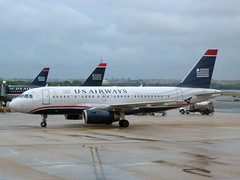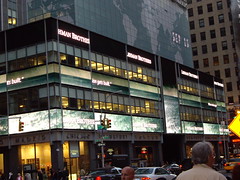As a tidal wave of business and consumer bankruptcies continues to drown our economy, those who have taken (or are considering) the bankruptcy plunge should at least know that they are not alone. In fact, since the turn of the century the U.S. has seen some of the biggest corporate bankruptcies ever. The following is a brief rundown of several high-profile and influential bankruptcies, all of which occurred over the past 8 years. The businesses are listed in the order of filing.
1. Pacific Gas & Electric Co.- April 2001
With soaring wholesale power costs outpacing retail prices as a result of California’s 1996 deregulation law, which prevents the higher costs from being passed on to customers, the Pacific Gas & Electric Co. filed for chapter 11 bankruptcy in April 2001. Pacific Gas & Electric Co., is a subsidiary of the nation’s largest utility holding company, PG&E Corp which provides power and natural gas to northern and central California. At the time of filing, Pacific Gas & Electric Co. had accumulated $12 billion in debt and $36 billion in assets.
2. Enron- December 2001
With $63.4 billion in assets, the Enron filing was the biggest bankruptcy in U.S. history until it was eclipsed by WorldCom the next year and Lehman Bros in 2008. Immersed in obscure accounting practices that concealed loses worth billions of dollars, Enron’s downfall will certainly be remembered as one of the most notorious scandals in history. In the end, Enron’s stock plummeted from a high of $90 per share in mid 2000, to just $0.10 a little over a year later causing stock holders to lose some $11 billion.
3. Global Crossing Ltd.- January 2002
Plagued by a combination of waning demand for telecommunications services in addition to reckless corporate and executive spending, the fiber-optic network operator Global Crossing Ltd, filed for bankruptcy protection in January 2002. At the time of its filing, Global Crossing had assets of $25.5 billion and liabilities of $14.6 billion, making it one of the biggest bankruptcy cases in U.S. history.
4. Adelphia Communications- June 2002
At its height, Adelphia Communications was the fifth largest cable provider in the United States. But that came to a pitiful end when founder John Rigas and his son Timothy were convicted for embezzling millions of dollars from the company, hiding $2.3 billion in debt, and deceiving investors about Adelphia’s profit and subscriber growth. Father and son received prison sentences of 15 and 20 years, respectively, and the company’s assets were later snapped up by Comcast and Time Warner in bankruptcy court.
5. WorldCom- July 2002
Just before filing for bankruptcy, WorldCom was considered one of the biggest long-distance companies in the U.S. With approximately $107 billion dollars in assets, its case was the second largest bankruptcy in history. WorldCom’s financial decline revolved around a massive accounting scandal in which the company’s total assets had been inflated by an estimated $11 billion.
6. Tyco International Ltd.- July 2002
In yet another example of executive scandal and corporate excess, former CEO Dennis Kozlowski and CFO Mark Swartz of the electronics giant Tyco International Ltd were found guilty of embezzling about $600 million from the company. Tyco filed for bankruptcy shortly thereafter.
7. US Airways- August 2002; September 2004
This troubled East-Coast airline filed for bankruptcy twice within a two year period. Though US Airways had a history of financial difficulty, the first bankruptcy filing was precipitated by September 11th terrorist attacks. The Reagan National Airport in Washington D.C., a major US Airways hub, stayed shut longer than any other airport. Even when the airport reopened, security delays mixed with a general reluctance to flying, adversely affected its profitable shuttle service between Washington, New York and Boston. Though it was able to get out of bankruptcy in 2003 after receiving a $1 billion loan from the Air Transportation Stabilization Board, it filed for bankruptcy again a year later after the airline was unable to secure $800 million in annual cost cuts from its workers’ unions.
8. Conseco- December 2002
Struggling with a $6.5 billion debt load, Conseco Inc. a well-known finance and insurance company, filed for chapter 11 bankruptcy protection in December 2002. Much of its debt was attributed to a string of impetuous acquisitions made during the 1990’s, including the ill-fated $6 billion purchase of Green Tree, the nation’s largest lender to mobile-home buyers. The company is also known for its generous spending. Shortly after the Green Tree acquisition, Conseco offered a $75 million contract to former GE executive Gary C. Wendt in the hopes that he could turn the beleaguered company around.
9. Trump Entertainment Resorts- November 2004; February 2009
Citing high interest payments on financing that prevented the refurbishment and expansion of its gambling hotels, Trump Hotels and Casinos filed for bankruptcy protection in November 2004. Though the company emerged from bankruptcy a year later under the name Trump Entertainment and Resorts, its financial difficulties continued as the current recession took hold causing a slump in the gambling industry. In February of this year, the company sought bankruptcy protection again a few days after founder Donald Trump quit the board. At the time of filing, Trump Entertainment listed assets of $2.06 billion and debt of $1.74 billion.
10. Delta Airlines- September 2005
After failing to post a profitable quarter since the year 2000, Delta Airlines, the nation’s third largest airline, could not sustain the sudden spike in fuel prices that came in the wake of Hurricane Katrina in addition to rising competition among low-fare carriers, such as Southwest Airlines. Another factor in Delta’s financial struggle included high labor costs, from which it was unable to secure concessions. Delta eventually exited bankruptcy in April 2007.
11. Northwest Airlines- September 2005
Just minutes after Delta Airlines announced that it was filing for bankruptcy, Northwest Airlines, the fourth largest carrier in the U.S., followed suit. Like Delta, Northwest was unable to sustain the increase in fuel prices and competition among low-cost carriers in addition to its high labor costs. The airline eventually emerged from bankruptcy in May 2007.
12. Delphi- October 2005
The bankruptcy case of Delphi, the largest auto parts maker in the U.S, has been shrouded in controversy. Delphi was originally established as a spin-off of GM, becoming a publicly-traded corporation in 1999. But it has since remained dependent upon GM for a significant portion of sales.
Many contend that the real purpose of Delphi’s creation was to prepare for a deep round of layoffs and wage cuts at both companies, and to shift pension obligations from the parent company to its spin-off. By filing for Chapter 11, Delphi was able to accomplish all this without union approval. Moreover, critics have been quick to harp on the fact that just a day before filing for bankruptcy in October 2005, Delphi increased the severance packages for 21 top executives claiming that it would be needed to keep them loyal to the company. The Delphi bankruptcy also paved the way for a series of sweeping rollbacks on auto workers at the Big Three in 2007, as well as the bankruptcies of GM and Chrysler.
13. Refco- October 2005
On October 17, 2005, just a mere three months after going public, Refco, a New York-based financial services company filed for Chapter 11 bankruptcy protection. The company’s financial downfall and eventual disintegration was attributed to a wide scale financial fraud in which Refco’s CEO and chairman, Phillip Bennett hid over $430 million in bad debt. At the time of filing, Refco posted assets of $33.3 billion and a debt that totaled $16.8 billion.
14. IndyMac Bancorp Inc.- July 2008
IndyMac Bancorp, based in Pasadena, California was at one time one of the largest mortgage lenders in the U.S. IndyMac once specialized in “Alt-A” home loans, those ubiquitous financial products that often did not require borrowers to fully document either their income or assets. As the rate of defaults increased, the lender eventually collapsed. Following comments made by U.S. Sen. Charles Schumer questioning IndyMac’s survival, customers scurried to withdraw more than $1.3 billion of deposits over 11 business days. Federal regulators seized the company, and less than three weeks later, it filed for Chapter 7 bankruptcy protection. At the time of filing, IndyMac’s assets totaled $32.7 billion, and its liabilities ranged between $100 million and $500 million.
15. SemGroup- July 2008
SemGroup, a major U.S. oil marketing company, filed for bankruptcy protection in July of last year after succumbing to $3.2 billion in losses on energy futures and derivatives trades that were supposed to hedge its physical oil trading business. On the surface, the Tulsa, Oklahoma-based company suffered from a combination of record high crude oil prices ( up to $150 a barrel) and a volatile credit market. But some assert that a scandal was brewing behind the company’s outstandingly poor performance. At the time of filing Semgroup had $6.1 billion in assets and $7.5 billion in liabilities.
16. Lehman Brothers- September 2008
The announcement a year ago that Lehman Brothers that had filed for Chapter 11 bankruptcy protection is considered the biggest and most complex bankruptcy case in history with company assets totaling over $600 billion. But greater than that, the downfall of Lehman Brothers, a financial behemoth and seemingly invincible Wall Street icon, sent waves of shock and disbelief across the world in a way that no other prior bankruptcy was able to accomplish. As the news spread, financial stocks plummeted world-wide. Many cite Lehman’s cultivation of a culture of corporate excess and risk taking, while shunning accountability at the major cause of its financial decline.
17. Washington Mutual- September 2008
“The Power of Yes!” The financial implosion at Washington Mutual (WaMu) was one of the most telling examples of the reckless lending and fraud that has helped fuel the current economic crisis. Several former employees have come forward to offer disturbing accounts of high risk loans being approved with little or no oversight and of a corporate culture with a “sweat shop” mentality. In the end, J.P. Morgan Chase purchased the failed bank for $1.9 billion in a deal brokered by federal regulators.
18. Tribune Group- December 2008
At the end of last year, Tribune Group, the newspaper and television chain that publishes The Los Angeles Times and The Chicago Tribune, filed for Chapter 11 bankruptcy protection. Part of the company’s financial problems stemmed from a sharp drop in advertising revenue brought on by the recession as well as a general shift of advertising to the Internet. But Tribune’s financial position worsened significantly by an attempt made by the company’s CEO Sam Zell to take the company private and thus claim a tax-exempt status. The move resulted in an employee stock ownership plan, which was basically wiped out after the company declared bankruptcy.
Another bizarre twist to the troubled company’s case allegedly involved former Illinois governor Rod Blagojevich. According to a criminal complaint filed against Blagojevich, the former governor was upset with editorial pieces that were critical of his performance and devised a plan to get the editorial writers fired which included a threat that the governor would block money for renovations to Wrigley Field (one of Tribune Group’s assets).
19. General Growth Properties, Inc- April 2009
General Growth Properties (GGP), the second-largest real estate investment trust and mall operator in the nation, filed for bankruptcy earlier this year spearheading one of the biggest commercial real estate bankruptcies in U.S. history. Facing a tight credit market and a weak economy that dampened consumer spending and put many mall occupants out of business, the Chicago-based company was unable to support the $27 billion in debt it had amassed in previous years by buying up malls and shopping centers. A large portion of that debt came from GGP’s 2004 strategic acquisition of Rouse Co., a Columbia, Md.-based real estate development and management company. The bankruptcy filing made in New York included most of the GGP’s malls which will continue to operate.
20. Chrysler- April 2009
On April 30th of this year, Chrysler became the first of Detroit’s Big Three automakers to file for bankruptcy protection largely in response to a dramatic slump in sales that has plagued the company since last fall. Touted by President Obama as a “pillar” of the industrial economy, Chrysler has already received some $7 billion in tax payer bailout money ($4 billion of which was handed over during the Bush Administration). The Obama Administration rushed to move the ailing automaker into bankruptcy protection so that the company could close a strategic alliance with Italian automaker, Fiat. There has been much public outcry over Chrysler’s bankruptcy case, especially over its new ownership structure as well as the recent “revelation” that the bailout money will not be repaid.
21. General Motors- June 2009
Just one month after Chrysler filed for bankruptcy, General Motors (GM) followed, earning the “distinction” as the fourth largest bankruptcy case in U.S. history. Even $19.4 billion in federal help was not enough to keep the trouble automaker out of bankruptcy court, and the government has further pledged another $30 billion to help the company during its reorganization. A “new GM” is expected to emerge out of bankruptcy that will revolve around a mere four brands, Chevrolet, Cadillac, GMC and Buick, as well as a few of its overseas operations.
In its wake, GM’s bankruptcy will have a major impact on a cross section of Americans. The move will result in the closure of numerous plants and dealerships, which means thousands of U.S. employees stand to lose their jobs. Moreover, approximately 650,000 retirees and their family members who rely on GM for health insurance will suffer cutbacks in their coverage. Investors holding $27 billion worth of GM bonds, stand to receive new stock in a reorganized GM worth a fraction of their original investment. Owners of current GM shares, will see their investments disappear.






